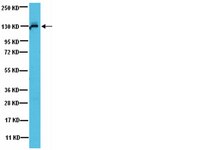07-1485 Sigma-AldrichAnti-JAK1 Antibody
Detect JAK1 using this Anti-JAK1 Antibody validated for use in WB.
More>> Detect JAK1 using this Anti-JAK1 Antibody validated for use in WB. Less<<Productos recomendados
Descripción
| Replacement Information | |
|---|---|
| Replacement Information | 07-1485 is a recommended replacement for AB3894 |
Tabla espec. clave
| Species Reactivity | Key Applications | Host | Format | Antibody Type |
|---|---|---|---|---|
| H, M, R | WB | Rb | Affinity Purified | Polyclonal Antibody |
| References |
|---|
| Product Information | |
|---|---|
| Format | Affinity Purified |
| Control |
|
| Presentation | Purified rabbit polyclonal IgG in 0.02 M Phosphate with 0.15 M NaCl, pH 7.6 and 0.1% sodium azide as a preservative. |
| Quality Level | MQ100 |
| Applications | |
|---|---|
| Application | Detect JAK1 using this Anti-JAK1 Antibody validated for use in WB. |
| Key Applications |
|
| Application Notes | Optimal working dilutions must be determined by end user. |
| Physicochemical Information |
|---|
| Dimensions |
|---|
| Materials Information |
|---|
| Toxicological Information |
|---|
| Safety Information according to GHS |
|---|
| Safety Information |
|---|
| Storage and Shipping Information | |
|---|---|
| Storage Conditions | Stable at 2-8°C in undiluted aliquots for up to 6 months from date of receipt. |
| Packaging Information | |
|---|---|
| Material Size | 100 µg |
| Transport Information |
|---|
| Supplemental Information |
|---|
| Specifications |
|---|
| Global Trade Item Number | |
|---|---|
| Número de referencia | GTIN |
| 07-1485 | 04053252325533 |
Documentation
Anti-JAK1 Antibody Ficha datos de seguridad (MSDS)
| Título |
|---|
Anti-JAK1 Antibody Certificados de análisis
| Cargo | Número de lote |
|---|---|
| Anti-JAK1 - 2087833 | 2087833 |
| Anti-JAK1 - 2192172 | 2192172 |
| Anti-JAK1 - 3482774 | 3482774 |
| Anti-JAK1 - NG1607368 | NG1607368 |
| Anti-JAK1 - NG1639037 | NG1639037 |
| Anti-JAK1 - NG1849432 | NG1849432 |
| Anti-JAK1 -2712436 | 2712436 |
Licencias necesarias e Información técnica
| Cargo |
|---|
| JAK/STAT Signaling Research Focus |








